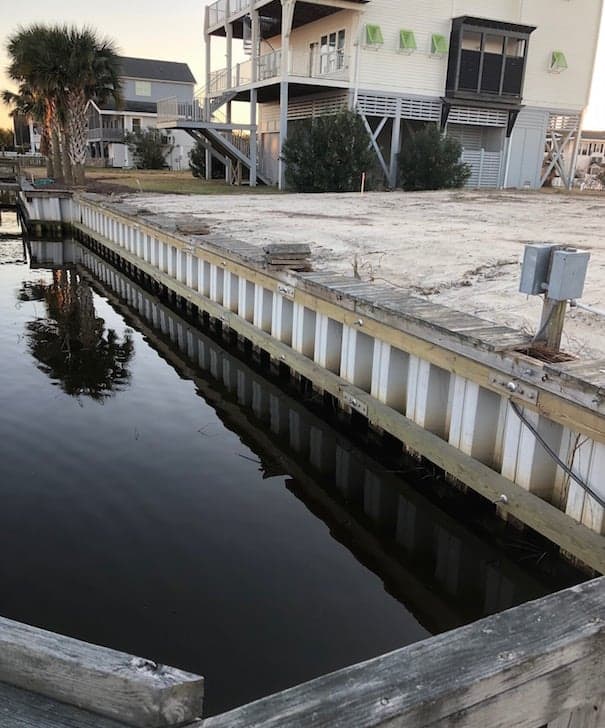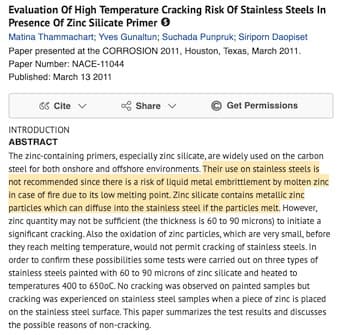
-----
Galvanic Action between Galvanized and Stainless Steel?
![]() Thank you all for your comments.
Thank you all for your comments.
Based on what I have read, I have decided to sleeve some stainless studding with PVC conduit where it passes through some galvanized lugs.
For the sake of a couple of £/$, it's a no-brainer.
Steel Fabrcator - Swindon UK
February 8, 2024
Multiple threads merged: please forgive chronology errors and repetition 🙂
Q. Hi,
Is it true that a corrosive reaction will take place if hot-dip galvanised and stainless steel products are clamped together?
Basically I sell steel channels and special beam clamps for suspending utilities eg. cable management systems, pipings, etc.
I was once cautioned by an engineer at a site by the shore oil plant project that we can't clamp a fastener (in my case it refers to a beam clamp) to a hot-dip galvanised steel beam. The thing was, we did not really get in detail about it as I thought he probably could have heard it from someone else. So, as it is important to my business, I need a professional view from you.
I have checked with a local galvaniser in Malaysia, they seem to have also heard/seen it somewhere but still haven't got any firm/documented reply pertaining to this.
In reference to the surrounding conditions, I was hoping we can evaluate this issue based on a general basis, ie.e, seaside, outdoor and indoor.
Nevertheless, is it true that a corrosive reaction will take place at the contact area of these two named metals?
In my knowledge, if the corrosion does occur, it will not spread as Zinc is self sacrificial.
Thank you very much.
Jeremy YapHokomo Trade Centre Sdn Bhd - Selangor, Malaysia
2001
A. I wouldn't do it, especially in very corrosive environments, because as you say, the zinc is sacrificial, and it will dissolve. After it is gone, there is nothing stopping the remaining steel from corroding with the stainless as the cathode.

Tom Pullizzi
Falls Township, Pennsylvania
A. I think the problem you fear, and which Tom confirms, would be real: spot corrosion of the beam in the area near the clamp. However, your closing sentence about self-sacrificial zinc probably isn't accurate. The fact that the corrosion occurs near the contact point rather than across the whole beam is probably a practical issue rather than a theoretical one. In theory, the corrosion would not be localized to the area of contact; rather the anodic current would be spread across the entire surface of the beam. But in the real world, a bit of water probably collects at the beam clamp rather than immersing the entire beam, so the galvanic current is restricted to the wetted area.

Ted Mooney, P.E.
Striving to live Aloha
finishing.com - Pine Beach, New Jersey
Ted can be retained for immediate
answers or long term project help
A. Jeremy,
As Ted and Tom imply, you could well have problems especially if the contacts got wet!
If you are concerned, why don't you play safe and, if you can, place some plastic all around the contact area? In other words chemically isolate that area. Another option is to 'paint' the contact points of your clamps with a suitable paint.
You will definitely have some corrosion or preferential corrosion if you join dissimilar metals together, that's the nature of the beast!
I am slightly biased towards plastics (40 odd years in this field) but the plastic clamps have nowhere the load bearing capacity of metal ones.
Food fer thought, as they say in bad English ... but you have an excellent command of this universal 'linqua franca'.
Cheers !

Freeman Newton [deceased]
(It is our sad duty to advise that Freeman passed away
April 21, 2012. R.I.P. old friend).
A. Zinc in contact with stainless steel is extremely dangerous in time of fire. There is a chemical reaction and that can cause an explosion. That is why stainless steel thermowells having union-nipple-union construction should NEVER be specified with galvanised union-nipple-union fittings, only black iron or stainless.
Michael Oser- Sydney, Australia
2003
A. Zinc will cause cracking of SS in case of fire (high temp.)
M Alabbasi- Kuwait
2007
A. Thanks, Michael & Alabassi. I am familiar with Alabassi's warning. I have not heard Michael's warning, but I suppose it's a matter of interpretation in that a highly pressurized stainless steel pipe or tank which becomes "liquid metal embrittled" by zinc could explode.
Luck & Regards,

Ted Mooney, P.E. RET
Striving to live Aloha
finishing.com - Pine Beach, New Jersey
Ted can be retained for immediate
answers or long term project help
A. If you couple zinc with stainless steel near the sea, you can get embrittlement of the stainless steel. This is due to the formation of atomic hydrogen when seawater breaks down and releases chlorine molecules.
As zinc is amphoteric it can be attacked by either very low or very high pH solutions. The hydrogen gas that forms can enter the molecular matrix of the stainless steel and expand, causing the steel to crack.
But please note that this normally only happens when the steel is under stress.
I have coated stainless steel with a zinc silicate many times over the years, and once the silicate was coated with a polyurethane primer and paint there was never any problem as the paint was a 'salt barrier' to the metals.
- Spalding, England
July 17, 2008
Multiple threads merged: please forgive chronology errors and repetition 🙂
Q. I am constructing a window screening device, and expect to have a stainless steel angle (probably Type 304, possibly 304L) frame come into constant contact (full-length) with a hot-dipped galvanized tube steel support frame back-up. Should I be worried about galvanic (two-metal) corrosion and separate the two metals (possibly with neoprene washers), or are the two metals close enough in the galvanic series that I don't need to worry (about corrosion to the zinc-covered hot-dipped steel frame)?
Andrew Clements- Austin, Texas
2003
A. The materials are actually very far apart galvanically. Zinc (the galvanized finish) is very cathodic to stainless steel and unless the area of the stainless steel is fairly small, it will accelerate the corrosion of the galvanized finish.

Ted Mooney, P.E.
Striving to live Aloha
finishing.com - Pine Beach, New Jersey
Ted can be retained for immediate
answers or long term project help
2003
A. Galvanised steel uses zinc as a sacrificial anode to protect the base metal. Stainless steel will be cathodic to the steel, so it will be even more cathodic to the zinc, hence you will get enhanced corrosion of the zinc. I would suggest you put plastic washers in the break any corrosion circuit

Trevor Crichton
R&D practical scientist
Chesham, Bucks, UK
2003
![]() Thank you for the responses.
Thank you for the responses.
- Austin, Texas
2003
Q. We are fixing a number of 304 stainless steel brackets onto a building one block away from the ocean with galvanised steel fixings. Can you advise if there will be a compatibility problem with these two metals.
Neil SotherenManufacturer - Brisbane, QLD, Australia
2004
A. My interpretation of the advice from the British Stainless Steel Assn. (see their site) is that this is likely to cause problems unless isolating washers are used. Fixing galvanized brackets using stainless nuts/bolts would probably be OK.
Stan Dwellback- Braintree, Essex, United Kingdom
January 24, 2011
Multiple threads merged: please forgive chronology errors and repetition 🙂
Q. Is there any reason to install an insulating element between the faying surfaces of a Stainless Steel member and a Galvanized Steel member? For construction reasons, it is necessary to have these two elements in permanent contact. Both members are located within a building with controlled climate conditions.
Thank You
John D. BernardEngineering and Construction - Boston, Massachusetts, USA
2004
A. I would recommend that you do put an insulating element between them even indoors. You cannot always control the humidity. What will the RH be in the building? If you can be absolutely sure that there is no moisture in the contact area you might get by with it. What kind of fasteners will be used to connect the two? That could cause you more problems.

Lee Kremer
Stellar Solutions, Inc.
McHenry, Illinois

2004
A. Insulating is to protect your galvanized zinc coating, not to protect the s.s. If your stainless steel surface area, compared to galvanized is small, and if you coated either of them, I believe it would be o.k.

Khair Shishani
aircraft maintenance - Al Ain, UAE
2004
A. In addition to concerns regarding galvanic transfer, liquid metal embrittlement must be considered in the event of a fire. Zinc attacks austenic material starting at 420 °C. The severity of the attack and consequences depend on heat and the stress level within the member. At 570 °C on highly stressed members the attack may be severe enough to result in rupture. I am not an expert, but please consult one. I advise this not because of the likelihood of an event, but because the failure mode could result in a sudden collapse as opposed to a progressive collapse that allow a safe exit for occupants of the structure.
Robert Hazleton- California
January 15, 2011
Q. I was just told by a dockmaster that nothing will happen to stainless steel props if they sit in the water. We are brackish here and I contend that eventually your zincs will get eaten and electrolysis will begin, even with stainless steel. Please tell me I have not been thinking wrong for 30 some odd years.
Audrey Crandall- Palm City, Florida
November 7, 2011
A. Hi, Audrey.
Electrolysis isn't quite the right word to use in talking about the situation. Electrolysis is about two pieces of metal (your prop and something else like a zinc anode) being in solution (seawater in this case) and exposed to an externally applied source of current (non-existent in the case under discussion), so that's not exactly what we have here whether the zinc anode is present or absent.
What we have instead is stainless (but not 100% corrosion proof) steel which can perhaps benefit from the sacrificial protection of zinc anodes in the same way that steel or aluminum do, although to a much smaller extent. In the real world there can be various factors, like two different stainless steels, or even a heavily cold worked area of one piece of stainless steel, that can lead to minor galvanic corrosion forces. A zinc anode will sacrificially protect against this. There can also be occasional electrical currents in marina waters that accelerate corrosion. I'd say zinc anodes can help even if most of the time the stainless steel props don't terribly need them.
Regards,

Ted Mooney, P.E.
Striving to live Aloha
finishing.com - Pine Beach, New Jersey
Ted can be retained for immediate
answers or long term project help
November 8, 2011
Q. Hi there, I'm building a walk in run for my chucks [chickens] and intend to use stainless steel mesh on a timber frame. Is it ok to use galvanised u-shaped nails on the stainless steel or will that cause a corrosive reaction? I'm struggling to source stainless steel u-shaped nails. Thanks. Rob
Rob WrightD.I.Y.er - Nottingham, U.K.
September 19, 2012
October 11, 2012
A. There can be different metal corrosion that occurs in some cases, but in this application likely not to be too big an issue.
But why use stainless mesh? That will surely be quite expensive? Galvanized mesh much lower cost, and then use galv. staples to secure?

Geoff Crowley
Crithwood Ltd.
Westfield, Scotland, UK

Q. I have a doubt: at site we installed stainless steel cladding in a galvanized frame without any rubber beading. Will any corrosion occur or some other problem happen; because in UAE temperature is high while summer time? I need some good suggestions for me to rectify that.
Regards,
installation engineer - Dubai, UAE
April 4, 2013
A. Hi Mohamed. If there is any moisture at all, significant corrosion of the galvanized frame will occur. Try to electrically isolate the two materials with the rubber beading you mentioned or in some other way.
Regards,

Ted Mooney, P.E.
Striving to live Aloha
finishing.com - Pine Beach, New Jersey
Ted can be retained for immediate
answers or long term project help
April 4, 2013
Q. Can I use stainless steel bolt on a grouted and threaded hole on a galvanised frame?
Abayomi Owoeye- Lagos, Nigeria
July 16, 2013
Q. I'm installing 308 stainless steel rectangular ductwork. Hung on stainless steel unistrut. Using 1/2" Galvanized all thread and hardware that passes through piloted holes in the stainless steel unistrut. Should I worry about electrolysis or corrosion at all?
Joseph buelnaLimbach - Rancho cucamonga, california, USA
May 29, 2015
Hi Joseph. If the installation is inside and in a dry area, probably not -- you can't have galvanic corrosion without moisture.
But the question always involves the issue of the seriousness of error or miscalculation, because the fact is that the stainless steel and galvanizing are not galvanically compatible. Good luck.
Regards,

Ted Mooney, P.E. RET
Striving to live Aloha
finishing.com - Pine Beach, New Jersey
Ted can be retained for immediate
answers or long term project help
June 2015
Q. Hi
We are working on concrete piles that support timber bearers. We use a stainless steel cable through the concrete pile and galvanised staples to tension the cable onto treated timber. Is there likely to be any corrosion between the two metals?
Many thanks
- Christchurch, New Zealand
June 1, 2015
A. Hi Paul. Corrosion issues are of course complex. But if the cathode area is very large (the stainless cable) and the anode area is small (the staples), that accentuates the seriousness of the corrosion. Another factor is the copper in the pressure treated wood, which is also highly corrosive to the zinc of the galvanizing, and to the steel after the galvanizing is gone. These factors have to be added to a consideration of the environment (wetness and saltiness) and a consideration of the seriousness of failure.
I don't know whether stainless steel staples are available, but if they are, that's probably what I'd be looking into. Good luck.
Regards,

Ted Mooney, P.E. RET
Striving to live Aloha
finishing.com - Pine Beach, New Jersey
Ted can be retained for immediate
answers or long term project help
June 2015
Stainless hardware on stainless cabinet is rusting
I have an exterior stainless steel cabinet that was assembled with stainless steel screws, washers & nuts. I am seeing a lot of rust on the assembly hardware. The manufacturer said:
This doesn't sound right to me.
Don Roney- Panama City Beach, Florida USA
July 9, 2015
A. Hi. It doesn't sound right to you, and it sounds completely ridiculous to me :-)
Probably the cabinet was passivated and the hardware was not, or the cabinet is of a higher grade of stainless than the assembly hardware.
By installing the hardware with steel tools, it has perhaps lost its passivation. You could either try to repassivate with a citric acid based passivation solution, or try to research if the hardware and cabinet are the same grade. I would guess that the cabinet is 316SS and the hardware is 303SS. Good luck.
Regards,

Ted Mooney, P.E. RET
Striving to live Aloha
finishing.com - Pine Beach, New Jersey
Ted can be retained for immediate
answers or long term project help
July 2015
July 28, 2015
A. Stainless Steel is rusting. No!! That can't happen. Worst name ever for any alloy. CRES (Corrosion REsistant Steel) is a much better name. No metal, under the right conditions, is corrosion proof. Not even Gold.
I think you got it right Ted. Dissimilar alloys in a salt air environment would be the right conditions. Especially after low alloy steel tools were used to assemble the cabinets.

Tim Hamlett, CEF
- West Palm Beach, Florida, USA
Q. Hi,
I am laying a wooden deck on a concrete slab. The frame for the decking is made of galvanized square tube. I am about to attach the wooden boards to the galvanized square tube. I was going to use galvanized screws to avoid corrosion issues. But the stainless steel ones look a much nicer finish. I'm not sure if the ratio's would allow it, but if anyone has any thoughts about drilling in SS screws I'd be interested to hear. The SS screw heads wont touch the gal as they will touch the wood. It's just the screws shafts which are about 4 to 5 mm wide. The galvanized square tube has a wall thickness of about 2 to 2.5 mm.
Thanks for any help!!
- Sydney Australia
November 2, 2015
A. Hi Al. I think the stainless screws are the best answer for this situation. Their surface area is small compared to the surface area of the galvanized tubing.
Regards,

Ted Mooney, P.E. RET
Striving to live Aloha
finishing.com - Pine Beach, New Jersey
Ted can be retained for immediate
answers or long term project help
November 2015
Q. I am installing composite deck boards as a backing to a raised flower bed. I need to span 86' and plan to use tie plates to connect the sections. I was planning to use stainless screws and plates. If I have trouble finding stainless plates, can I use stainless screws with galvanized plates without a corrosion reaction between the two?
Eileen Hall- Oak Lawn, Illinois, USA
May 13, 2016
A. Hi Eileen. If stainless plates are unavailable or too expensive, you should probably switch to galvanized fasteners for the galvanized plates.
Realistically though, it's probably not a big deal if you already have the stainless screws because, although the galvanizing will corrode to protect the screws, the screws are presumably small compared to the plates.
Regards,

Ted Mooney, P.E. RET
Striving to live Aloha
finishing.com - Pine Beach, New Jersey
Ted can be retained for immediate
answers or long term project help
May 2016
Q. in our project, we are using SS316L pipes for fire fighting services. and to support this pipes we are suspending with GI clamps.
To avoid di-electric reactions, Do I need to place Rubber Lining in between GI Clamps & Stainless steel pipe.??? or there will be no any di-electric reactions between these two metals...???
please support with your answers.
- SAUDI ARABIA
April 5, 2017
A. Hi Shajahan. It doesn't sound like a good idea to skip the "rubber lining". The surface area of the pipe is much greater than the hangers, so the galvanizing will probably corrode away quickly if there is any conductive moisture. Also, see the comments regarding zinc embrittlement of stainless steel. It doesn't sound difficult to insulate between the pipe and the hangers though.
Regards,

Ted Mooney, P.E. RET
Striving to live Aloha
finishing.com - Pine Beach, New Jersey
Ted can be retained for immediate
answers or long term project help
April 2017
SS Trailer Cladding on Galvanized Frame?
Q. Afternoon.
I am currently building a food trailer. The floor and superstructure is out of 1.6 mm galvanised sheet metal and the cladding I want to use is 0.7 mm 430 or 304 SS. The galv. uprights are 90 mm wide and the cladding is 1100 mm x 2000 mm. Reading posts on this forum it looks like this is a bad idea given that I also live at the coast. The other option is to use 0.8 mm Chromadek, but I would prefer to use the SS if at all possible. Any advice other than the obvious and use Chromadek.
Product Designer - Port Elizabeth South Africa
June 22, 2017
Ed. note: Chromadek is apparently hot-dip galvanized sheeting with a primer and top coat.
Q. I have stainless steel connected to a galvanized piece that is powder coated. Do I still need to worry about corrosion? This is an outdoor structure on a bridge.
John HaennyChicago Ornamental Iron - Chicago Illinois USA
June 8, 2018
A. Hi John. Ideally, there shouldn't be a metallic connection between dissimilar metals, and that would solve the problem. But if that isn't possible, then it becomes a question of the severity of the overall circumstances.
- On the negative side is that frequent wetness, and corrosive and ionically conductive de-icers are probably to be expected on a bridge.
- On the positive side is that stainless steel tends to not carry high galvanic currents because its chromic oxide skin isn't conductive, and powder coated materials, except where they are scratched or broken, won't carry any.
- The unknown factors for me are the area of the stainless compared to the galvanized area (if low, then galvanic currents corroding the powder coated and galvanized surface are minimized), and the criticality of corrosion (is the bridge structure at risk, or is there any other realistic threat to life?)
Regards,

Ted Mooney, P.E. RET
Striving to live Aloha
finishing.com - Pine Beach, New Jersey
Ted can be retained for immediate
answers or long term project help
June 2018
Q. Our condo on the FL Gulf Coast will be replacing the fabric awnings on the top floor of our garage after 19 years. While we do this, we want to replace some or all of the rusted bolts holding the galvanized steel frame together. It would seem hot dip galvanized bolts and nuts would be the best fit [no pun intended] but the fabricator quoting the job is specifying 304 SS because he says the zinc coating spalls off quickly and the bolts rust.
Reading the literature, SS bolts would seem okay since they are small compared to the anodic galv framework but they cost much more. And then, some say it should be 316, not 304.
Open to suggestions.
Dave

David Landsperger
- Sarasota, Florida, USA
January 30, 2019
A. Hi David. Although I acknowledge that plating & galvanizing can peel if poorly done, I've personally never witnessed the galvanizing flaking or spalling off a nut or bolt in the field in my own experience. Hopefully someone who galvanizes such hardware will reply with some statistics or inside info. Yes, passivated 316SS is ideal, but if a little surface rust/discoloration isn't a big issue, 304 will probably do.
Regards,

Ted Mooney, P.E. RET
Striving to live Aloha
finishing.com - Pine Beach, New Jersey
Ted can be retained for immediate
answers or long term project help
February 2019

Q. Hi, I am repairing a bulkhead on the NC coast and have galvanized tie backs to the deadmen. I was planning on using 316 Ogee washers and bolts, but this does not appear to be such a good idea. Some will below water level at high tide and some will not.
What do you think?
Thanks,
- Charlotte, North Carolina USA
March 19, 2019
A. Hi Steve. I'm just the site curator with some limited personal experience in a few topics, not a bulkhead builder. But my experience with my own bulkhead and deck on a salt water lagoon is that the new pressure treated wood (ACQ) is so corrosive to zinc and steel due to its high copper content, that any additional corrosive effect caused by stainless steel is probably roundoff error not to be fretted over. I don't see any upside to stainless though :-)
BYou may find that your stainless nuts won't fit galvanized threads, which are much bigger to allow for the galvanizing thickness.
Regards,

Ted Mooney, P.E. RET
Striving to live Aloha
finishing.com - Pine Beach, New Jersey
Ted can be retained for immediate
answers or long term project help
March 2019
A. We have G90 coated steel framing an exterior ceiling on a barrier island coast of Florida. Very humid. Would it be acceptable to hang a sheet product using stainless steel drywall screws? This will also be stuccoed.
John Snow- Jupiter Island, Florida
April 3, 2019
A. Hi John. I see some concerns expressed above regarding issues like "liquid embrittlement" and explosion hazard" which I am unfamiliar with but which sound exaggerated or remote for your particular situation, but you might check building codes to see if there is any prohibition of stainless fasteners with galvanized ceilings. I think galvanized or at least zinc plated or painted drywall screws would be a better idea.
Regards,

Ted Mooney, P.E. RET
Striving to live Aloha
finishing.com - Pine Beach, New Jersey
Ted can be retained for immediate
answers or long term project help
April 2019
Q. I want to install stainless steel 316 flat sheet to side of gal purlin in swimming pool environment, fixed with class 5 screws any issues ?
Martin RichardsRoofing - Melbourne Vic Australia
May 23, 2019
June 20, 2019
A. Yes there are issues in using dis-similar metals in contact with each other in such an environment.
You could use insulating washers to insulate the dis-similar metals. The issue isn't proximity, but contact as in electrical contact. Isolate them from each other (plastic washers or similar) and the problem is avoided.

Geoff Crowley
Crithwood Ltd.
Westfield, Scotland, UK

Q. I'm building a rolling keg cooler. I have a 3/4" stainless steel rod that I was going to use as the axle. My plan has been to run it through 3/4" galvanized standard pipe that is mounted to the bottom of the cooler. Loaded, the cooler will be fairly heavy. I intend to use it occasionally outside, sometimes at the beach. Mostly it will be stored in my garage. Will the stainless rod in the galvanized pipe cause an issue? If so, what would be a good remedy? Thank you!
David McCully- Orangeburg, South Carolina, U.S.A.
June 20, 2019
A. It is possible to double dip your product to get a thicker coating of galvanization for a little more protection against corrosion.
Zara Lou- Bradford,Yorkshire
June 24, 2019
A. For this purpose I would not worry about the issue. When you use your carriage on the beach, wash it with fresh water when you get home to reduce the salt.
In theory the SS rod inside the galv pipe will be a dissimilar metals galvanic corrosion issue, but probably not any more noticeable than the wear of a dry axle than is worth worrying about.
You could put in a grease nipple and add some grease!

Geoff Crowley
Crithwood Ltd.
Westfield, Scotland, UK

June 26, 2019
Stainless steel fasteners on galvanized deck
Q. Would there be any concern about using stainless steel screws with sealing washers to fasten a 20 ga. galvanized metal deck to painted structural steel members? We have this situation on a truck canopy that is being built. There is no roofing over the metal deck - the deck and structural steel members are sloped.
Edmond Thayer- Oak Ridge, Tennessee USA
September 23, 2019
A. Hi Edmond. Galvanized screws seem like a much better idea -- is there a reason you can't use galvanized fasteners? If you can't, is there a reason you can't use insulating bushings along with washers to prevent galvanized surfaces from contacting stainless ones? Between the potential for galvanic corrosion and the dangers in fire situations that Alabbasi mentions, stainless screws contacting galvanized decking sounds troublesome.
Regards,

Ted Mooney, P.E. RET
Striving to live Aloha
finishing.com - Pine Beach, New Jersey
Ted can be retained for immediate
answers or long term project help
September 2019
![]() Thanks for the quick response! You confirmed our thoughts.
Thanks for the quick response! You confirmed our thoughts.
- Oak Ridge, Tennessee USA
September 23, 2019
Q, A, or Comment on THIS thread -or- Start a NEW Thread
